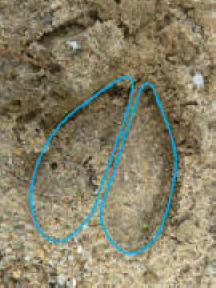Science: Wildlife Tracks and Signs
Wildlife Along The Greenway
The City of Lowell boasts a great amount of wildlife from wood
frogs to fishers, and monarch butterflies to peregrine falcons. The
Concord River Greenway Park (Greenway) is no exception. Wild
animals are everywhere, but knowing where to find them is often a
matter of developing some tracking skills and observational
techniques.
A helpful hint to get you started: Think of yourself as a
detective. The key to observing wildlife tracks and signs is to
search for clues, imagining the behaviors of animals, thinking about
what the animals were doing when they left their evidence behind.
Interpret the scene. This will help you to be successful at
learning about the types of animals living along the Greenway and
other nearby habitats.
Always remember, a good detective never destroys the evidence, so
be careful not to walk on the tracks of wild animals or disturb
other evidence of their presence.

|

Eastern
gray squirrels have many remarkable adaptations giving them
an advantage when it comes to finding food, water, and
shelter.
Look for signs of squirrels high up in trees. They
are known for their large, elaborate nest-like
homes, called “dreys”, which are made of
mostly sticks and leaves. Their tracks are perhaps the most
commonly observed of any animal throughout the year.
|
|
Wild Vs. Domestic: Food, water, and shelter
All living things need food, water, and shelter to survive. Where
these resources are found, wild animals are, too.
What is a wild animal? What is a domestic animal? Where do
they get their food, water, and shelter?
Wild animals, such as squirrels and crows need to find their own
food, water, and shelter, where as domestic animals, such as farm
animals and pets depend on their owners to provide these essential
resources. The Concord River is an ecosystem known for its
abundance of natural resources, which support a wide range of
wildlife habitats.
| A mother raccoon scurries with her young along
Centennial Island. Raccoons are wild animals, because they
find their own food, water, and shelter.
Wild animals are often nocturnal and are seldom observed.
However, to the keen eye their tracks and signs appear all
around, all the time. |

|
|

|
Dogs enjoy walks along the Greenway, too. This dog
is a domestic animal, because its owner provides for it
food, water, and shelter. The tracks of domestic dogs and
cats are often seen along the Greenway and may be confused
with the tracks of wild animals. |






